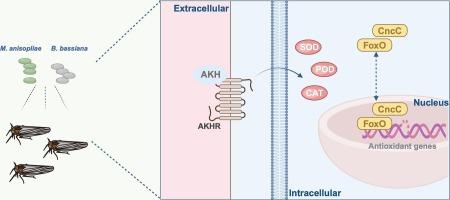AKH/AKHR signalling system induced antioxidant response mediated by entomopathogenic fungi in Nilaparvata lugens (Stål)
IF 4.2
1区 农林科学
Q2 BIOCHEMISTRY & MOLECULAR BIOLOGY
引用次数: 0
Abstract
The brown planthopper Nilaparvata lugens is one of the most economically important rice crop pests in Asia. Entomopathogenic fungi (EPF) have been developed as a biological control of N. lugens. Insect adipokinetic hormones (AKHs) are pleiotropic hormones that play a protective role in response to oxidative stress. However, the role of AKH in the anti-oxidative response of N. lugens to EPFs (Metarhizium anisopliae and Beauveria bassiana) infection remains largely unexplored. In this study, the results of relative enzyme activities and expression levels of antioxidant enzymes demonstrated the response of the antioxidant system of N. lugens to EPF infection. Additionally, the expression of AKH/adipokinetic hormone receptor (AKHR) also induced responding to the infection of EPF in N. lugens. Silencing NlAKH or NlAKHR significantly increased mortality in nymphs treated with fungi compared with controls, whereas the injection of AKH peptide decreased mortality. Further research indicated that the AKH/AKHR system positively influenced antioxidant enzymes, potentially involving the transcription factors forkhead-box O and Cap’ n’ collar C. These findings provide an important theoretical basis for developing new pest control agents targeting the neuropeptide AKH and offer new insights for mitigating brown planthopper resistance and promoting green control strategies.

Nilaparvata lugens (Stål) 昆虫病原真菌介导的 AKH/AKHR 信号系统诱导的抗氧化反应
褐飞虱 Nilaparvata lugens 是亚洲经济上最重要的水稻害虫之一。昆虫病原真菌(EPF)已被开发为一种生物防治 N. lugens 的方法。昆虫脂肪动力激素(AKHs)是一种多效激素,在应对氧化应激时发挥保护作用。然而,AKH 在 N. lugens 对 EPFs(Metarhizium anisopliae 和 Beauveria bassiana)感染的抗氧化反应中的作用在很大程度上仍未得到探讨。在本研究中,抗氧化酶的相对酶活性和表达水平结果表明了 N. lugens 的抗氧化系统对 EPF 感染的反应。此外,AKH/诱导激素受体(AKHR)的表达也对N. lugens感染EPF产生了诱导反应。与对照组相比,沉默NlAKH或NlAKHR会显著增加用真菌处理的若虫的死亡率,而注射AKH肽则会降低死亡率。进一步的研究表明,AKH/AKHR 系统对抗氧化酶有积极影响,可能涉及转录因子叉头盒 O 和 Cap' n' collar C。
本文章由计算机程序翻译,如有差异,请以英文原文为准。
求助全文
约1分钟内获得全文
求助全文
来源期刊
CiteScore
7.00
自引率
8.50%
发文量
238
审稿时长
4.2 months
期刊介绍:
Pesticide Biochemistry and Physiology publishes original scientific articles pertaining to the mode of action of plant protection agents such as insecticides, fungicides, herbicides, and similar compounds, including nonlethal pest control agents, biosynthesis of pheromones, hormones, and plant resistance agents. Manuscripts may include a biochemical, physiological, or molecular study for an understanding of comparative toxicology or selective toxicity of both target and nontarget organisms. Particular interest will be given to studies on the molecular biology of pest control, toxicology, and pesticide resistance.
Research Areas Emphasized Include the Biochemistry and Physiology of:
• Comparative toxicity
• Mode of action
• Pathophysiology
• Plant growth regulators
• Resistance
• Other effects of pesticides on both parasites and hosts.

 求助内容:
求助内容: 应助结果提醒方式:
应助结果提醒方式:


